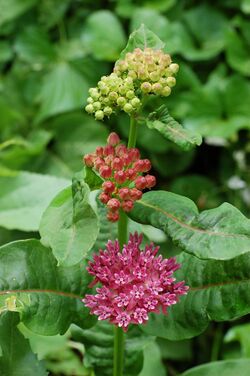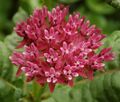Biology:Asclepias purpurascens
| Purple milkweed | |
|---|---|

| |
| Scientific classification | |
| Kingdom: | Plantae |
| Clade: | Tracheophytes |
| Clade: | Angiosperms |
| Clade: | Eudicots |
| Clade: | Asterids |
| Order: | Gentianales |
| Family: | Apocynaceae |
| Genus: | Asclepias |
| Species: | A. purpurascens
|
| Binomial name | |
| Asclepias purpurascens | |
Asclepias purpurascens, the purple milkweed, is a herbaceous plant species. It is in the genus Asclepias, making it a type of milkweed. It is native to the Eastern, Southern and Midwestern United States similar to the range of the common milkweed (Asclepias syriaca). The plant gets its name from the flowers that first develop a pink color but then turn darker purple as they mature. Unlike common milkweed, purple milkweed prefers some shade and is considered a plant of partial shade. It is also considered an indicator of oak savanna, especially in Wisconsin.[1] The species rarely produces seed pods which are smooth, instead of the rough warty ones produced by common milkweed.[2]
Conservation status in the United States
It is listed endangered in Massachusetts and Wisconsin, officially as historical to Rhode Island (though with two recently discovered yet meager pouplations), as imperiled in Maryland[3] and as a special concern species in Connecticut[4] and Tennessee .[5]
Uses
Like other members of the milkweeds, several insects live off the plant, including the monarch butterfly (Danaus plexippus), the milkweed beetle (Tetraopes tetraophtalmus), large milkweed bug (Oncopeltus fasciatus), small milkweed bug (Lygaeus kalmii) and milkweed leaf beetle (Labidomera clivicollis).[citation needed] Other insects and pollinators feed off the flower's nectar.
This species is sometimes cultivated in gardens designed to attract butterflies, but is less common than the light purple swamp milkweed (Asclepias incarnata) or the orange butterfly weed (Asclepias tuberosa). The nectar of the plant attracts many other species of butterflies and insects.
Gallery
Young developing plants show foliage reminiscent of Asclepias syriaca.
A red ant feeding on the flower's nectar
References
- ↑ Thomas D. Brock. "Ecology and Conservation of Purple Milkweed" (PDF). http://pleasantvalleyconservancy.org/pdf/Purple%20milkweed%20paper.pdf.
- ↑ "Asclepias purpurascens L. Purple milkweed". http://www.newfs.org/docs/pdf/Asclepiaspurpurascens.pdf.
- ↑ ""List of Rare, Threatened, and Endangered Species of Talbot County"". https://dnr.maryland.gov/wildlife/Documents/Talbot_County_RTEs.pdf.
- ↑ "Connecticut's Endangered, Threatened and Special Concern Species 2015". State of Connecticut Department of Energy and Environmental Protection Bureau of Natural Resources. Retrieved 31 December 2017.(Note: This list is newer than the one used by plants.usda.gov and is more up-to-date.)
- ↑ "Plants Profile for Asclepias purpurascens (Purple milkweed)". https://plants.usda.gov/core/profile?symbol=aspu2.
- Blanchan, Neltje (2005). Wild Flowers Worth Knowing. Project Gutenberg Literary Archive Foundation.
Wikidata ☰ Q310133 entry
 |













